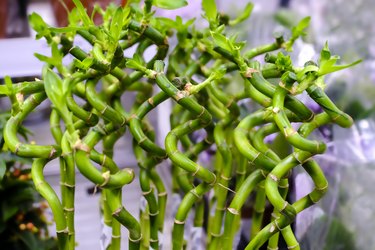
If you're partial to houseplants, there's a lot to like about lucky bamboo (Dracaena sanderiana, USDA hardiness zones 9-12). It's easy to grow, doesn't get too large, doesn't need direct sun and you can even train it into cool and unusual shapes. If you have pets or small children in the house, a potential issue with houseplants is toxicity. Lucky bamboo is a reasonably safe option, having little to no toxicity for humans and only mild to moderate toxicity for dogs and cats.
Tip
Lucky bamboo has little to no toxicity for humans but mild to moderate toxicity for cats and dogs.
Video of the Day
A Quick Lucky Bamboo Primer
The first thing to know about lucky bamboo is that it's not a bamboo at all despite the visual resemblance. It's actually a member of the surprisingly large asparagus family, or Asparagaceae. One of the reasons for lucky bamboo's popularity is that it's hard to kill through overwatering. Unlike garden asparagus, which hates wet feet, lucky bamboo can even be grown in water if you change the water diligently to prevent disease.
Video of the Day
That's unsurprising given that the plant is native to the rain forest jungles of Africa and southeast Asia. Aside from plentiful water, its other major requirements are warmth and — because it's an undercanopy plant in its native habitat — not too much direct sun.
Lucky Bamboo Toxicity for Humans
It's unlikely that an adult human would attempt to eat a lucky bamboo unless the person is already thoroughly intoxicated. The situation is different with toddlers, of course, so prudent parents will be relieved to know that there's very little risk from Dracaena sanderiana.
Though lucky bamboo is sometimes considered a nontoxic plant, that's a slight oversimplification because the plants do contain compounds called saponins that can cause an upset stomach if they're eaten in large enough quantities. They're only a concern if you actually ingest the plant, and unless you're especially sensitive, you shouldn't have to worry about developing a rash (contact dermatitis) from handling it.
Lucky Bamboo Toxicity for Pets
The risks for pets are higher, though still not typically life-threatening. If you have a cat or dog that likes to chew on your houseplants, you'll definitely want to keep your lucky bamboo in a place where it's difficult to reach. Although your pets won't get seriously ill unless they eat a lot of Dracaena, it can certainly give them — and you — a few unpleasant hours.
The saponins found in lucky bamboo and other closely related Dracaena species, including popular houseplants such as the corn plant (Dracaena fragrans) and dragon tree (Dracaena draco or Dracaena marginata), can cause mild to moderate symptoms in both dogs and cats.
These include vomiting and diarrhea, continuous drooling, abdominal pain, weakness and lack of coordination (you may notice your pet staggering and weaving as if drunk). In the case of cats, you may also notice dilated pupils. If your pet shows some combination of these symptoms and there is no other obvious cause, check your lucky bamboo for damage. You may also wish to contact your vet and arrange for your pet to be monitored if the symptoms don't pass within a few hours.